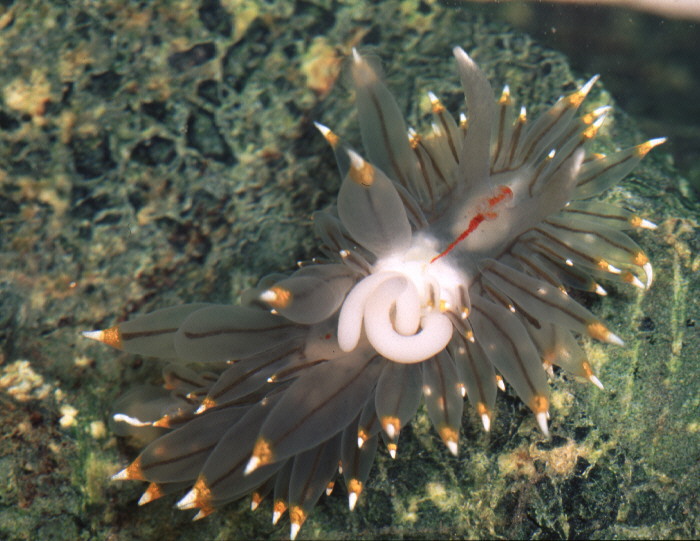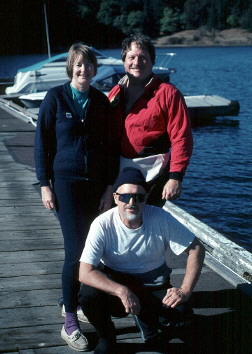 |
What is that thing? Two long white worm-like objects protrude from the back of a nudibranch like an alien life form. These are the egg sacs of a parasitic copepod. The copepods burrow into the nudibranch as juveniles and grow in the blood cavity, absorbing digested nutrients. Inside the nudibranch, the parasite is entwined around its hosts own organs, but does not appear to damage these organs. Some parasitized nudibranchs do show the effects of parasitization by having small gonads or no gonads, called parasitic castration, but this may not be the case with northeastern Pacific species.
Copepods are small crustaceans, generally free-living on the ocean bottoms or swimming in the plankton where they feed on phytoplankton and in turn provide a food source for other animals. They have cylindrical bodies, segmented posteriorly and ending in two feathery tail pieces. The large antennae can be used for swimming, in a rowing motion and they have one median eye. The nudibranch parasites have lost the eye, reduced the antennae and the body has become swollen and lumpish looking with large, claw like legs, 2 pairs in the smaller male, three in the female (see Belcik, 1981; Ho, 1981; Jensen, 1987; Schrödl, 1997). The female has two elongate, usually white, egg sacs which protrude out through the body of the host. The eggs release planktonic nauplius larvae which search for a new host.
Opisthobranchs are hosts to four genera of parasitic copepods all belonging to the Family Splanchnotrophidae. In the northeastern Pacific, only the genus Ismaila has been reported, but information is sparse in the literature (Jensen, 1987, Schrödl, 1997) and it appears that there are a great number of undescribed species and unreported hosts to be discovered. Dendronotus iris has its own parasite Ismaila occulta according to Ho (1981) who found 425 parasites in one nudibranch. Janolus fuscus (above) , reported by Belcik (1981) to have Ismaila monstrosa, was found to actually have an undescribed species now called Ismaila belciki by Ho (1987). It is possible a different parasite will occupy each different nudibranch host. Other northeastern Pacific hosts of unknown parasitic species are Archidoris sp., Aglaja diomedia, Dirona sp., Triopha sp., and possibly Eubranchus sp. according to Belcik (1981). I can confirm that copepod parasites are found in Dirona albolineata and Triopha catalinae. I can also add to the local list of hosts, the species Ancula gibbosa, Diaphorodoris lirulatocauda, Doto amyra and Doto kya. Keep your eyes open and I'm sure you will be able to add a lot more.
References
Belcik, F.P. 1981. The male of Ismaila monstrosa Bergh, 1867 (Copepoda,
Splanchnotrophidae). Crustaceana 40:16-25.
Ho, J.S., 1981. Ismaila occulta, a new species of poecilostomoid copepod
parasitic in a dendronotid nudibranch from California. J. Crust. Biol. 1:
130-136.
Ho, J.S., 1987. Reconsideration of Ismaila monstrosa Bergh, 1867 (Copepoda,
Splanchnotrophidae) from Oregon. Crustaceana 52(1): 109-111.
Jensen, K. 1987. Ismaila monstrosa Bergh (Copepoda: Splancnotrophidae)
found parasitizing in Ercolania funerea (Costa) (Gastropoda: Ascoglossa).
Ophelia 28(1): 75-84.
Schrödl, M. 1997. Aspects of Chilean nudibranch biology: Effects of
splanchnotrophid copepod parasitism on Flabellina sp. 1 (Mollusca,
Nudibranchia). Opisthobranch Newsletter 23(12): 45-47.
Taxanomic information courtesy of Sandra Millen
Doto kaya and Triopha catalinae photo credits courtesy of Ron Long

| Sandra can be seen at left with Alan Grant (standing) and myself(kneeling) during a recent trip report to Vancouver Island, British Columbia, Canada. Although not immediately obvious during the underwater filming, parasitization was indicated during land "tub shot" sessions. Later review of video footage and slides revealed multiple cases of parasitization. If you would like to contact Sandra for additional information on this subject, the following may be of assistance:
University of British Columbia Vancouver, B.C., Canada, V6T 1Z4 Phone (604) 822-2087; Fax (604) 822-2416 Send Sandra E-Mail at millen@zoology.ubc.ca or visit Sandra's Home Page
|
|
|
© The Slug Site, Michael D. Miller 1998 All Rights Reserved.
